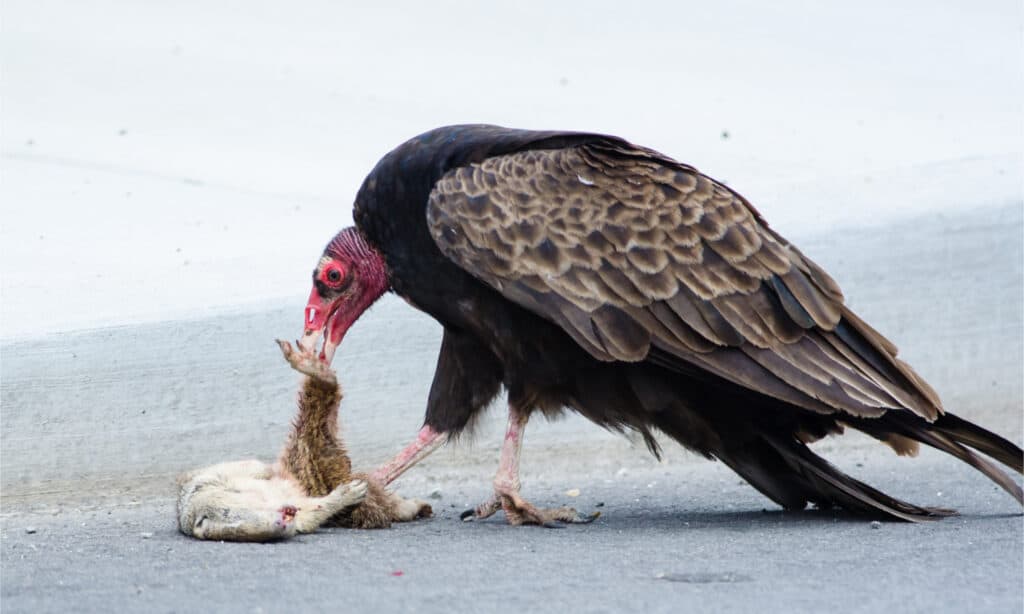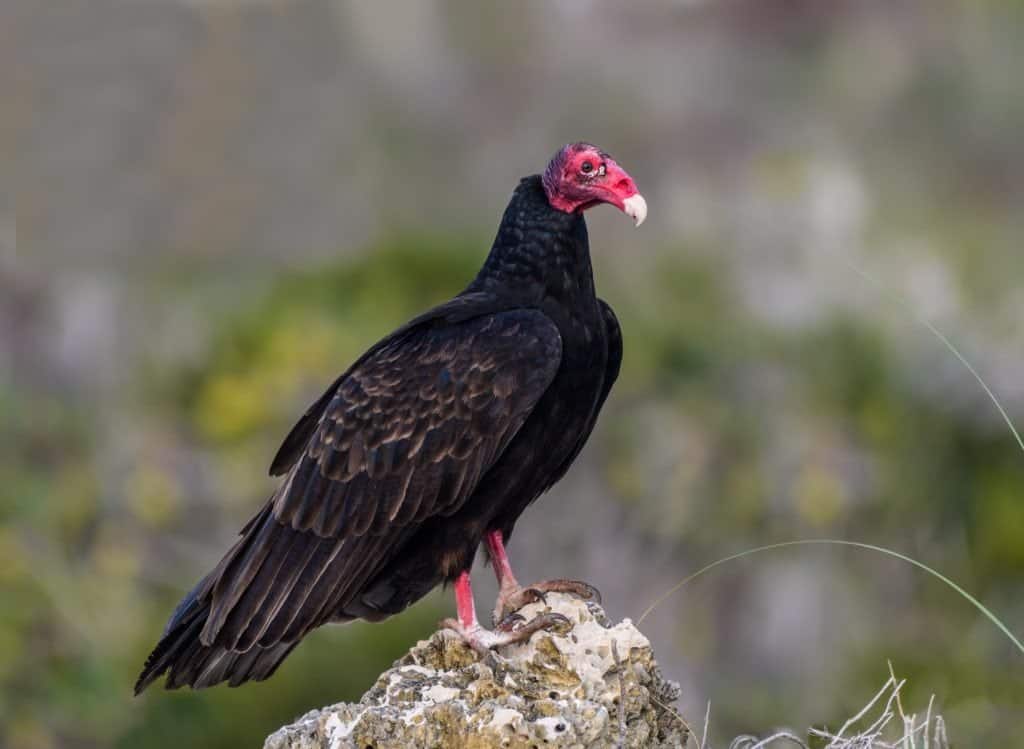To put it simply, a vulture is a bird of prey that consumes carrion. Like a crow or raven, vultures are typically not regarded as desirable animals, and Hollywood has used their distinctive profile as a villain in vintage cartoon movies. However, their distinctive traits and enormous size distinguish them from almost all other raptors. Although people frequently view the intimidating-looking vulture as an annoyance or a sign of death, the birds are an essential component of the natural ecosystem.
These scavenger birds remove dead animal materials from the environment that can contain hazardous bacteria and diseases by opportunistically feeding on whatever is left over from other animals’ kills. But many species are seeing a sharp reduction in their population due to human activity. Luckily enough for Texas, vultures are quite common and not endangered. All year-round, residents and visitors alike can enjoy the view of these majestic birds of prey. But what vultures are in Texas? And where can we find them? Below, we will explore the vulture world of the Texas lands, what they eat and look like, and other interesting facts.
Background on Vultures
Contrary to common belief, “vulture” does not refer to a specific group’s classification in science. Instead, it is the colloquial term for various birds that consume carrion and have comparable traits. Taxonomists currently divide vultures into more than 20 species, and Old World and New World vultures are the two main divisions. These two groups are not all that closely linked despite having many things similar. The Accipitridae, which also contains eagles, hawks, kites, and harriers, includes Old World vultures. The Cathartidae, a component of an entirely different order, includes New World vultures.
The vulture has been important to human culture throughout history. In the past, they were frequently seen on the front lines of conflict, preying on dead combatants or civilians. In some African folklore, the bird is said to have a supernatural ability to sense dead or dying prey.
The vulture illustrates convergent evolution, in which two groups widely dissimilar in taxonomy independently evolved identical traits and behaviors. In other words, they evolved to fill a comparable niche despite coming from different evolutionary lineages. The turkey vulture, California condor, and Andean condor are examples of vultures found in the New World. The Egyptian vulture, Griffon vulture, European black vulture, bearded vulture, and Indian vulture are examples of vultures from the Old World.
Are There Vultures in Texas?

Texas is home to the black vulture and the turkey vulture.
©hubert999/Shutterstock.com
In the United States, there are three different species of vultures, and Texas is home to two of them. The black vulture and the turkey vulture are the two species found in Texas. They may appear similar, but if you know what to look for, you can easily tell them apart.
Vultures have evolved to live a life of carrion consumption. For instance, as they burrow themselves in decaying meat, their featherless heads and necks help keep them clean. Additionally, vultures have strong stomach acids that expose them to harmful substances, including rabies, distemper, botulism, the black plague, and anthrax, without experiencing any negative effects.
2 Types of Vultures in Texas
1. Black Vulture

The black vulture has an approximate size of 28 inches.
©Holly Guerrio/Shutterstock.com
The name “black vulture” is fitting for these birds of prey. This bird resembles an avian Grim Reaper due to its dark black and gray mottled feathers and bald black head. It can be recognized from the air because the white feathers beneath its wings resemble stars.
Appearance
Black vultures retain their large, rounded wings flat and slightly forward-angled while flying. The tail is rounded and quite short, they have tiny, bald heads, and their bills are thin yet firmly hooked. Except for white spots or “stars” (quite tricky to see in strong light or from afar) on the bottom of their wingtips, these birds are all black. The head’s exposed skin is also black.
Since they can be hefty relative to their wingspan and have wingspans reaching up to five feet wide, they frequently find thermals to fly in. The black vulture has an approximate size of 28 inches (2 feet), a wingspan of roughly 1.6 meters (5 feet), and can weigh up to 2.3 kg (5 lb). In general, black vultures are thought to be the more aggressive of the two vulture species and have even been observed occasionally capturing live victims.
Habitat
The black vulture prefers to hunt in open environments. They nest and reproduce on tall trees like sycamores, hickories, oaks, junipers, pines, and bald cypress in wooded areas. Black vultures typically build their nests under protection in shadowy crevices. Instead of making a nest, they deposit their eggs in hollow logs, rocky crevices, caves, tree holes, and floors of deserted buildings.
Black vultures can be found in both open and wooded habitats in Texas. Although they search for food along roads, fields, and other open spaces, they prefer to roost and build their nests in deep woodlands. Black vultures can be seen in Texas’ southern regions close to major cities like Houston and Dallas.
According to reports, black vultures are a local species. Although they are more prevalent in southern areas, this species can be found as far north as Ohio and even in New England states. They can be observed flying as far south as Chile and Uruguay in South America and as far north as the beaches of New York or the northeastern United States.
Diet
Black vultures consume carrion like many vultures do. They employ both sight and scent to detect carcasses, unlike many Old World vultures solely using sight. They frequently gather in huge numbers when feeding and may consume a carcass rather quickly. Black vultures typically favor recently deceased material – about 1-3 days old. They contain unique bacterial colonies in their digestive system, like most vultures, which enables them to consume rotting meat.
In contrast to the majority of other vultures, black vultures are known to kill animals for their fresh meat occasionally. They prey on live opossums, skunks, and animals, including calves, newborn pigs, and lambs.
2. Turkey Vulture

Turkey vultures frequently roost or nest next to black vultures and favor open woodlands.
©FotoRequest/Shutterstock.com
Turkey vultures can be seen often in both North and South America. These vultures resemble turkeys and are distinguished by their broad wingspan and unhurried flight habits.
Appearance
The name “turkey vulture” is derived from its appearance. Turkey vultures resemble their namesake with red heads, gray wingtips, and black-brown bodies, albeit they are significantly smaller, barely weighing 3 pounds and standing 2.5 feet tall. Their legs are either light brown or black, and the soles of their wings are brown and white.
These enormous birds, which have a 6-foot wingspan, can be seen swooping high above, searching for and smelling dead things to eat. Despite having a broader wingspan than the black vulture, they weigh nearly the same, at about 3 lbs.
Habitat
The range of turkey vultures is comparable to that of the black vulture. They can be found in the eastern United States down to the southernmost point of South America. They have a range extending as far south as the southern United States and as far north as southern Canada, particularly during the winter when they migrate. They typically prefer wide-open spaces and sizable remote areas to nest. They gather on light poles and other man-made structures and are most frequently seen early in the day on sunny days.
Turkey vultures frequently roost or nest next to black vultures and favor open woodlands. They are frequently spotted flying overhead while moving through open forests or close to roads. They are also frequently observed alongside black vultures while consuming roadkill.
Diet
Like most vultures, turkey vultures feed on carrion. However, unlike black vultures, they only consume carrion because their talons are worthless for hunting prey. They utilize their headless arms to remove the meat from carcasses without getting debris caught on their heads.
A turkey vulture will consume nearly anything dead, but small to medium-sized mammals make up most of their diet. They are not particularly choosy and will also consume fish, reptiles, and other birds. They typically wait until a carcass can be disassembled since they lack the strength to shred the flesh off freshly killed prey completely. Turkey vultures frequently eat roadkill as part of their diet.
Are Vultures in Texas Dangerous?
Since vultures generally eat carrion or dead meat, there’s no reason to fear them. Despite their terrifying role in myths and legends, vultures are harmless to humans. Furthermore, because they are so effective at clearing up human and animal waste from our towns, villages, and roadways, vultures are helpful to people.
The photo featured at the top of this post is © oguenaydin/Shutterstock.com
Thank you for reading! Have some feedback for us? Contact the AZ Animals editorial team.






